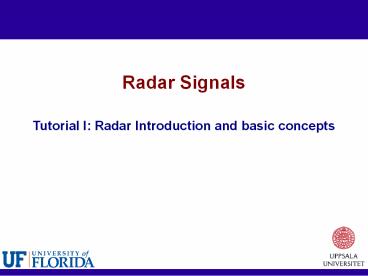Radar Signals - PowerPoint PPT Presentation
Title:
Radar Signals
Description:
Creating a Project Report ... Tutorial I: Radar Introduction and basic concepts Outline Introduction to radar Radar history Radar principles Radar category Two ... – PowerPoint PPT presentation
Number of Views:431
Avg rating:3.0/5.0
Title: Radar Signals
1
Radar Signals
Tutorial I Radar Introduction and basic concepts
2
Outline
- Introduction to radar
- Radar history
- Radar principles
- Radar category
- Two important concepts
- Doppler effect
- Matched filter
3
Radar history
- First radar test (1904)
- German high frequency engineer Christian
Hulsmeyer - Traffic supervision on water he measures the
running time of electro-magnetic waves to a metal
ship and back - An aircraft was first located by radar in 1930
- Lawrence A. Hyland (Naval Research Lab)
- Radar development underwent a strong push during
World War II
4
Radar principles
- A radar does nothing but measures the round-trip
time delay ? the range R c t / 2
radar radio detection and ranging
5
- The radar beam can be focused to a specific
direction ? azimuth and elevation - Radars work in high frequencies
- High resolution (small wavelength ? small object)
- Small antenna size
Mechanical rotation / phased-array
6
Frequency ranges
GHz
Airborne radar (small size, shirt range, high
resolution)
Over the horizon (high power, low resolution)
7
The radar equation
received power (w)
transmitted power (w)
antenna gain
effective antenna aperture (m2)
radar cross section (m2)
8
Range ambiguity
- The radar time is set to zero each time a pulse
is transmitted - If echo signals from the first pulse arrive after
the second pulse transmission, ambiguity arises
Maximum unambiguous range
9
Range resolution
- Without intra-pulse modulation
- is the pulse width
- With intra-pulse modulation and range compression
- is the bandwidth of the pulse
- very small resolution
- 100 MHz ? 1.5 m
10
Angular resolution
- High directivity of radar antennas ? small beam
width ? small resolution
11
Classification of radar systems
12
Doppler effect
A
( )
13
Taylor expansion
14
- What if wideband signals?
- We cannot simply inverse T
- The received signal is a time-scaled and delayed
version of the transmitted signal - If bandwidth lt 0.1 carrier frequency, it is
reasonable to assume that the motion causes only
a Doppler shift to the carrier frequency.
envelop of the signal affected
15
Complex representation of signals
- Majority are narrow bandpass signals
16
(No Transcript)
17
Matched filter
- Probability of detection is more related to SNR
rather than the exact shape of the waveform - A matched filter maximizes SNR at the output of
the filter
18
Equality holds if and only if
Matched filter output
Auto-correlation function
19
- The matched filter
- Its impulse response is linearly related to the
time-inverted complex-conjugate signal - When the input to the matched filter is the
correct signal plus white noise, the peak output
is linearly related to the signal's energy. - At the peak output, the SNR is the highest
attainable, which is 2E / N0 - The response is described by the autocorrelation
function of the signal
20
(No Transcript)
21
MF response to Doppler-shifted signals
Ambiguity function
The AF describes the output of a matched filter
when the input signal is delayed by tau and
Doppler shifted by nu relative to nominal values
for which the matched filter was designed.
22
(No Transcript)
23
To be continued...
- Ambiguity function
- Various properties
- Basic radar signals
- Constant frequency pulse
- Linear-frequency modulated pulse
- A train of pulses
Thank you Sep. 2009






























